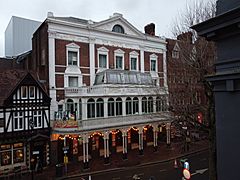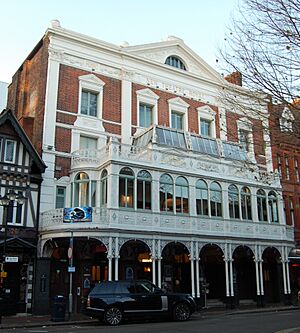New Theatre Royal facts for kids

New Theatre Royal facade
|
|
| Address | 20–24 Guildhall Walk Portsmouth England |
|---|---|
| Coordinates | 50°47′47″N 1°05′36″W / 50.7965°N 1.0932°W |
| Owner | New Theatre Royal (Portsmouth) Trustees Ltd |
| Designation | Grade II* |
| Type | Visiting productions / Receiving house |
| Capacity | 648 |
| Current use | Theatre |
| Construction | |
| Opened | 1884 |
| Renovated | 1900, 1970s, 2004 and 2012-15 |
| Reopened | 1900, 1976, 2004, 2015 |
| Years active | 1884–present |
| Architect | Charles J. Phipps (1884) Frank Matcham (1900) |
The New Theatre Royal is a historic theatre in Portsmouth, England. It was built a long time ago, during the Victorian era. This special building can hold 648 people. It started as a hall in 1854 and became a theatre two years later. Famous architects like Charles J. Phipps and Frank Matcham rebuilt it over the years. The theatre had a big makeover and reopened in 2015.
Contents
Discover the Theatre's Past
Charles Dickens and Old Portsmouth Theatres
The New Theatre Royal stands where an older theatre used to be. That first theatre was in High Street, in what is now called "Old Portsmouth." The famous writer Charles Dickens even wrote about this theatre in his book Nicholas Nickleby.
Many famous performers visited the old theatre. These included the amazing violinist Niccolò Paganini and the talented composer Franz Liszt. The theatre closed in 1854. It was pulled down to make space for a military building. This building is now Portsmouth Grammar School.
The entrance to the school is where the old theatre once stood. Old city records show posters from 1824 for plays there. They also have paintings of what the theatre looked like. It was a low building with no windows. Inside, it had two levels of seating boxes.
Did Dickens Perform Here?
Charles Dickens was born in Portsmouth. He visited the theatre in 1838 to research his book, Nicholas Nickleby. Dickens was a great writer and also loved to perform. His public readings were very popular.
Some people think he might have performed at the old Portsmouth Theatre. However, this is probably not true. He started his public performances much later in his life. He did perform in Portsmouth later, but at a different hall.
Henry Rutley and the First Theatre Royal
In 1856, after the old theatre was gone, a man named Henry Rutley opened a new one. He was a showman who owned a circus. Rutley bought a hall called Landport Hall and turned it into a theatre.
The new Theatre Royal opened on September 29, 1856. It was very successful. The theatre often showed two plays a night. There were also afternoon shows on weekends. Rutley managed the theatre until he died in 1874.
Amazing Architects
C. J. Phipps: A Master Builder
After Rutley, J. W. Boughton took over the theatre. He decided to rebuild it completely. He hired C. J. Phipps, who was the most famous theatre architect of his time. Phipps had designed many theatres in London.
The new building opened on August 4, 1884. It had four levels of seating for the audience. The theatre showed how society was divided back then. Wealthy people used six doors to enter the best seats. Other people used single doors on the side.
The stage was very large, about 40 feet deep. It also had a tall "fly tower" above the stage. This allowed scenery to be flown in and out.
Frank Matcham: The Genius of Theatre Design
The theatre was so popular that Boughton decided to make the stage even bigger. In 1900, he hired Frank Matcham to update the building. Matcham was one of the greatest theatre architects in UK history.
He built over 150 theatres across the country. His designs made sure everyone had a great view of the stage. He also made stages that sloped down towards the audience. This helped people in the upper seats see better.
Matcham was also a genius at making theatres sound amazing. He designed the stage and seating area to act like a giant bell. This helped voices and music fill the theatre. Comedian Jimmy Tarbuck once said about Matcham's London Palladium that you can "feel the sound roll around the theatre."
Matcham made the Theatre Royal stage much larger. He also added a glass room to the front of the building. This gave more space for people to relax during breaks. The stage even had a special "treadmill" feature. This allowed horses and carriages to appear to move on stage! It was used in the yearly pantomime. It's believed two racing chariots appeared in a "Ben Hur" show after the renovation.
Matcham also designed two more theatres in Portsmouth: the Prince's Theatre and the Kings Theatre. The Kings Theatre, which opened in 1907, is still open today.
Famous Stars on Stage
Many famous performers from the late 1800s and early 1900s appeared at the Theatre Royal.
- Sir Henry Irving and Ellen Terry, a famous acting pair, performed there many times.
- Sarah Bernhardt, a legendary French actress, also performed there. She even signed her name on a dressing room wall! This signature was saved after a fire in 1972.
- Marie Lloyd, a popular music hall star, was a regular performer.
- Even Laurel and Hardy, before they became huge Hollywood stars, performed here. Oliver Hardy chose the theatre for his birthday party in 1954.
- Morecambe and Wise, famous comedians, also performed early in their careers.
Sir Henry Irving's last full performances were at the Theatre Royal in Portsmouth. His private secretary, Bram Stoker, who wrote the famous novel Dracula, worked backstage during some of these shows.
Theatre Shows in the Past
In the past, especially before World War II, theatres offered lots of entertainment. They often had "two shows nightly" with extra shows on weekends. There was a main show and a shorter, supporting show. People could pay to see one or both.
This meant actors had a lot of work! They might play the main character in a serious play like "Hamlet" at the start of the week. Then, they would be the lead in a funny play later that same week. This needed an amazing memory!
The Theatre Royal Becomes the New Theatre Royal
For a long time, theatres needed a special "royal charter" to perform plays. This allowed them to be called "Theatre Royal." This is why so many old theatres have that name. The Portsmouth Theatre gained this special permission.
Rutley's theatre became the "Theatre Royal" in 1856. This was probably because he promised it would be a respectable place for families.
It's not clear exactly when people started calling it the "New" Theatre Royal. The official name was "Theatre Royal" until 1976. But people informally added "New" much earlier. You can even see both names on the front of the building. The theatre officially became the New Theatre Royal in 1976 when a special trust was formed to look after it.
A Time of Change
By the 1920s, new entertainment like radio and cinema became popular. This meant fewer people went to the theatre. Many theatres closed or became cinemas. The Theatre Royal became a cinema in 1932.
During World War II, Portsmouth was heavily bombed. The theatre next door was destroyed, but the Royal was lucky and survived. It stayed a cinema until 1948, then went back to showing live variety acts. In 1954, it even hosted one of the first live rock 'n' roll shows in the UK!
However, with television becoming popular, the theatre struggled again. It closed in 1955. For a while, it was a bingo hall and a place for wrestling.
In 1966, the owners wanted to knock the theatre down. They called it "an eyesore." But a group of people fought to save it! The plan to demolish it was stopped by just one vote.
The empty building started to fall apart. Thieves stole valuable parts. In 1968, people even lived there without permission. This led to the creation of the Theatre Royal Society. This group worked hard to protect the building. Actor Brian Murphy, who grew up in Portsmouth, was part of this campaign. This society later became the New Theatre Royal trust in 1976.
Filming "The Boy Friend"
In 1971, the director Ken Russell chose the theatre for his film version of the musical "The Boy Friend." The story is a love story set in the 1920s. Russell added a twist: he set the film in a run-down theatre.
The film starred ballet dancer Christopher Gable and model Twiggy. It also featured famous actors like Barbara Windsor and Brian Murphy. Ken Russell filmed most of the movie inside the empty theatre. This gave the film a very real and old-fashioned feel. It was the last performance for the Victorian theatre before disaster struck.
The Fire
In 1972, a year after the film, children accidentally set the stage on fire with fireworks. The back of the theatre was quickly ablaze. Luckily, the safety curtain fell into place. This saved the main seating area from being destroyed.
Once again, people wanted to knock the theatre down. But the Theatre Royal Society fought back. Brian Murphy, the actor from "The Boy Friend," was one of the campaigners.
In 1975, volunteers were allowed into the building to start repairs. A trust was officially set up in 1976 to care for the theatre. It was now officially the New Theatre Royal. Slowly, the theatre was repaired, mostly by volunteers. In 1984, a small stage was built. For a while, only amateur shows could be performed.
Amazing Finds
The theatre has lost some things over the years. Thieves stole brass fittings in the 1960s. In the 1970s, thieves even stole doors that had been removed for renovation. Many old posters and records from the theatre also disappeared.
However, some special items were saved! Sarah Bernhardt's signature, which she left on a dressing room wall, was rescued after the fire. The trust now owns it.
In the early 2000s, builders found old posters from the 1860s under the floorboards of a house in Southsea. Several of these were bought for the theatre trust.
Bringing the Theatre Back to Life
In 2003, the theatre received a large grant of £440,000. With this money, the beautiful cast iron entrance was fixed. New heating was installed, and a new bar was added. They even got vintage seats for the main seating area! These seats had been used in the movie "Moulin Rouge."
A larger stage was built, and the theatre started to offer many different shows. These included plays, comedy, music, and dance. They also worked with local schools and community groups. The New Theatre Royal became an important part of Portsmouth's cultural scene.
"Let's Make It Great"
The theatre's leaders decided to rebuild the stage and backstage areas. They also planned to add teaching facilities for the university. In 2009, architects were hired to design the new building. A fundraiser was appointed to raise £4 million.
The fundraising program, "Let's Make It Great," began in 2010. It included a special gala performance. Comedian Sandi Toksvig hosted the event. Actress Sheila Hancock, who is a patron of the theatre, was the main star. Many other famous people performed, including musician Paul Jones.
In May 2010, the theatre showed "The Boy Friend" film again. This was the first time in almost 30 years! The director Ken Russell and cast members like Twiggy and Brian Murphy were there. After this event, Twiggy, Sir Peter Maxwell Davies, and Brian Murphy also became patrons of the theatre.
Images for kids




